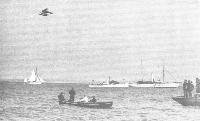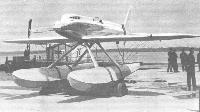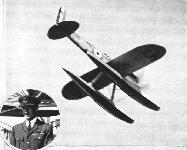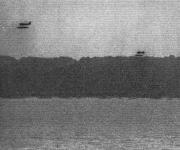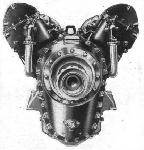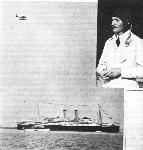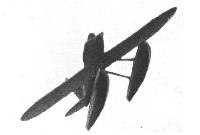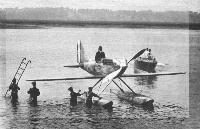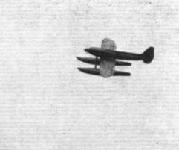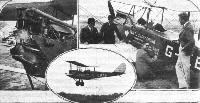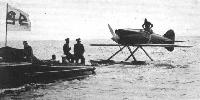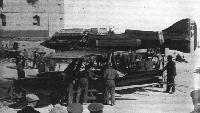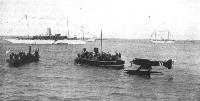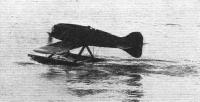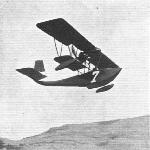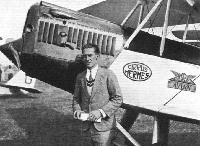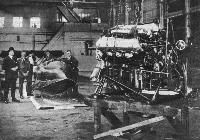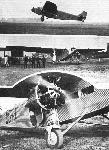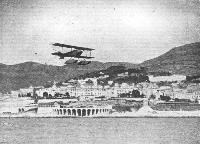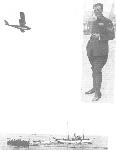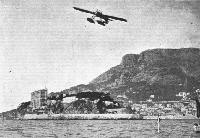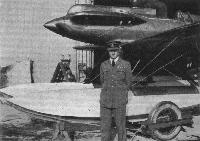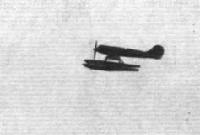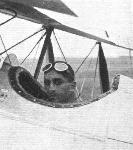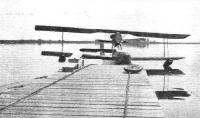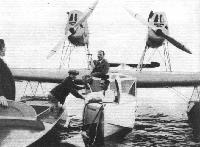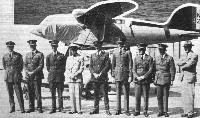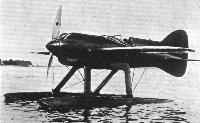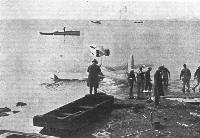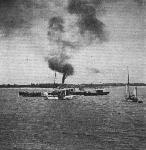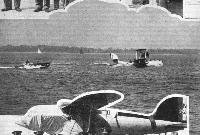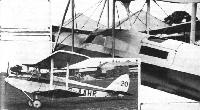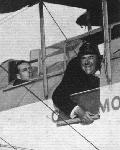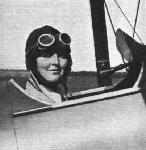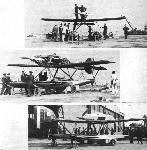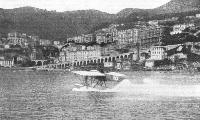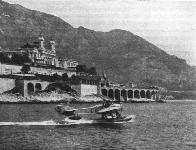Фотографии
-
"ALSO FLEW": THE RESERVE STANDARD "HAWK" SEAPLANE (500 H.P. CURTISS D.12) ON WHICH LIEUT. TOMLINSON, U.S. NAVY, SECURED FOURTH PLACE WITH 137 M.P.H.!
Самолёты на фотографии: Curtiss F6C / P-1 / Hawk / Model 34 - США - 1925
-
Регистрационный номер: G-EALQ AT BOURNEMOUTH: THIS VIEW SHOWS THE ONE OF FOUR COMPETITORS IN THE 1919 CONTEST STARTING OFF THE PIER. VINCENT NICHOLL ON THE FAIREY
Самолёты на фотографии: Fairey Fairey III - Великобритания - 1917
-
One of types of seaplanes, which took part in the seaplane meeting at La Baule. The French Navy also sent some Farman ''Goliath" (168) bombers, fitted with two 480 h.p. "Jupiter" engines, one of which is shown here.
Самолёты на фотографии: Farman F.62BN.4 / F.160 Goliath - Франция - 1922
-
LIEUT. CUDDIHY'S CURTISS R.3C.4 RACER, 700 H.P. CURTISS V.1550, WHICH WAS NOT FAR BEHIND THE WINNER UNTIL FORCED DOWN ON THE LAST LAP.
Самолёты на фотографии: Curtiss R2C / R3C - США - 1923
-
xMERICA'S FIRST WIN: LIEUT. RITTENHOUSE, ON THE NAVY-CURTISS RACER, WINNING THE SCHNEIDER TROPHY AT COWES, 1923, WITH A SPEED OF 177-38 M.P.H.
Самолёты на фотографии: Curtiss R2C / R3C - США - 1923
-
THE TENTH SCHNEIDER WINNER: THE SUPERMARINE-NAPIER S.5 (GEARED NAPIER "LION") ON WHICH FLIGHT-LIEUT. S. N. WEBSTER WON THE CONTEST FOR 1927. IT WAS AN IMPROVED DEVELOPMENT OF THE PREVIOUS YEAR'S S.4.
Самолёты на фотографии: Supermarine S.5 / S.6 - Великобритания - 1927
-
Регистрационный номер: N219 [2] READY FOR THE FRAY: The Supermarine machines going out to the navigability trials. The S.5 in the foreground and the two S.6's a little farther from the camera.
Самолёты на фотографии: Supermarine S.5 / S.6 - Великобритания - 1927
-
The two successful types: In the foreground, the Supermarine-Rolls-Royce S.6 of 1929, and behind, the Supermarine-Napier S.5.
Самолёты на фотографии: Supermarine S.5 / S.6 - Великобритания - 1927
-
Регистрационный номер: N219 [2] AN IMPRESSION OF SPEED: Flight-Lieut. D'Arcy Greig (inset) and the outdated Supermarine S.5 N219, in which he creditably completed the course, flying low over Ryde Pier. Average speed for course 282-11 m.p.h.
Supermarine S.5 N219 being flown by Flt Lt D'Arcy Grieg at the 1929 Schneider race at Calshot.Самолёты на фотографии: Supermarine S.5 / S.6 - Великобритания - 1927
-
Регистрационный номер: N247 [7] "SITTERS": The six machines at their buoys during the 6 hours' watertightness test.
Самолёты на фотографии: Macchi M.39/M.52/M.67 - Италия - 1926Supermarine S.5 / S.6 - Великобритания - 1927
-
Регистрационный номер: N247 [7] THE WINNER OF THE 1929 SCHNEIDER TROPHY CONTEST
Самолёты на фотографии: Supermarine S.5 / S.6 - Великобритания - 1927
-
Регистрационный номер: N247 [7] The most exciting moment in the Schneider Contest: Waghorn on the Supermarine S.6 (No. 2) overtaking Dal Molin on the Macchi M.52 (No. 4)
Самолёты на фотографии: Macchi M.39/M.52/M.67 - Италия - 1926Supermarine S.5 / S.6 - Великобритания - 1927
-
The most powerful Aero Engine in the World: The Rolls-Royce Type "R" Engine fitted in the Supermarine S.6, which won the Schneider Trophy Contest, and which has since established a World's Speed Record of 357-7 m.p.h. Note the extremely small frontal area.
Самолёты на фотографии: Supermarine S.5 / S.6 - Великобритания - 1927
-
Регистрационный номер: N247 [7] ALONG THE HAMPSHIRE COAST: Flying Officer Waghorn heading for the West Cowes turning point.
Самолёты на фотографии: Supermarine S.5 / S.6 - Великобритания - 1927
-
Регистрационный номер: N247 [7] THE WINNER OF THE 1929 SCHNEIDER TROPHY CONTEST: Flying Officer H.R.D.Waghorn (inset) crosses the finishing line over the Orient liner "Oxford," after having covered the 350 km. course at an average speed of 328-63 m.p.h. He was flying an all-metal Supermarine S.6 monoplane, fitted with Rolls-Royce "R" type racing engine.
Самолёты на фотографии: Supermarine S.5 / S.6 - Великобритания - 1927
-
Регистрационный номер: N247 [7], N248 IN THE NAVIGABILITY TRIALS: Waghorn's Supermarine S.6 going out, and Atcherley's S.6 taxying,
Самолёты на фотографии: Supermarine S.5 / S.6 - Великобритания - 1927
-
Регистрационный номер: N220 A FINE BANK BY WEBSTER ON THE SUPERMARINE-NAPIER S.5 MONOPLANE.
Самолёты на фотографии: Supermarine S.5 / S.6 - Великобритания - 1927
-
Регистрационный номер: N247 [7] Fg Off H. R. D. Waghorn aged 25 was the surprise winner of the race and flew an extra lap by mistake, running out of fuel as he did so. Waghorn’s mount was the Supermarine S.6 N247.
MORE THAN SIX MILES A MINUTE: Sqdn.-Ldr. Orlebar coming ashore after establishing a new World's speed Record in the Supermarine S.6. During the flight he must repeatedly have exceeded a speed of six miles a minute, and very probably at times he was doing nearly 400 m.p.h.!Самолёты на фотографии: Supermarine S.5 / S.6 - Великобритания - 1927
-
AFLOAT AND A-WING AT CALSHOT. THE SUPERMARINE S.6.
Самолёты на фотографии: Supermarine S.5 / S.6 - Великобритания - 1927
-
Siskin manoeuvrings: The R.A.F.'s part in the meeting.
Самолёты на фотографии: Armstrong Whitworth Siskin - Великобритания - 1921
-
A Canadian Commemoration: To commemorate the tenth anniversary of the first transatlantic flight by Alcock and Brown, the Royal Canadian Air force marked the occasion at the annual Inspection of the Military Units at Camp Borden, Ont., by christening two of the latest Armstrong-Whitworth Siskin IIIA machines (Armstrong-Siddeley supercharged "Jaguars"). They were christened, by the Hon. Brig.-Gen. A. H. Bell, C.M.G., D.S.O., "Sir John Alcock" and "Sir Arthur Whitten Brown."
Самолёты на фотографии: Armstrong Whitworth Siskin - Великобритания - 1921
-
Регистрационный номер: G-EBTD [2] 1,000 HOURS BETWEEN OVERHAULS: A few years ago this would have appeared out of the question. Yet the de Havilland "Gipsy" engine, in a "Moth," has just completed 600 hours, so that we are well on the way. One of these photographs shows, Mr. Eadon, who has sat behind the "Gipsy" during a large proportion of the 600 hours, is seen chalking up the final "hourage." Interested onlookers are Mr. Tuck, of the Hoyt Metal Co., who is interested in the bearings, Mr. Collins, an apprentice who has had much to do with the reliability test, and, on the right, G. de Havilland, Jun., one of several pilots who have helped to pile up a mileage of well over 50,000 miles. The "Gipsy" will now be put on the test bench to have power curves taken, and will then be stripped for examination.
Самолёты на фотографии: De Havilland Moth / D.H.60 - Великобритания - 1925
-
Регистрационный номер: G-EBUF "THE MASTER AND HIS MINIONS": Capt. T. Neville Stack, A.F.C., Chief Pilot and Air Superintendent, on the left in the Hermes Moth and on the right his pilots show the result of his organisation.
Самолёты на фотографии: De Havilland Moth / D.H.60 - Великобритания - 1925
-
Регистрационный номер: G-EBTD [2] Mr. Geoffrey de Havilland, Jr., adds a few more hours to EBTD's score.
Самолёты на фотографии: De Havilland Moth / D.H.60 - Великобритания - 1925
-
One of types of seaplanes, which took part in the seaplane meeting at La Baule. The C.A.M.S.37 flying boat, powered with a 450 h.p. Lorraine-Dietrich engine; several of these were entered by the French Navy.
Самолёты на фотографии: CAMS CAMS 37 - Франция - 1926
-
MAJ. DE BERNARDI'S MACCHI M.39 MONOPLANE, WITH 800 H.P. FIAT, ON WHICH HE WON THE TROPHY FROM AMERICA AT HAMPTON ROADS, 1926. HIS SPEED WAS 246-496 M.P.H.
Самолёты на фотографии: Macchi M.39/M.52/M.67 - Италия - 1926
-
NAVIGABILITY TESTS COMPLETED: Dal Molin, on Macchi M.52, being towed to his buoy for the 6 hours' watertightness test.
Самолёты на фотографии: Macchi M.39/M.52/M.67 - Италия - 1926
-
A FORMIDABLE CHALLENGER The Macchi M.67 is fitted with an 18-cylinder, broad-arrow type Isotta-Fraschini engine.
Самолёты на фотографии: Macchi M.39/M.52/M.67 - Италия - 1926
-
"NOT LESS THAN 12 KNOTS": Monti’s Macchi M.67, No 10, taxiing in amidst a halo of spray during navigability trials in the Solent.
Самолёты на фотографии: Macchi M.39/M.52/M.67 - Италия - 1926
-
A SCHNEIDER INCIDENT: Lieut. Monti, one of the Italian Schneider competitors, who was forced down off Hayling Island, was "salved" by a Royal Navy pinnace, and later handed over to the care of the R.A.F. launch. Our picture shows the latter taking the Macchi 67 in tow, while Lieut. Monti goes aboard and the steam pinnace, on the extreme left, proceeds on its way.
Самолёты на фотографии: Macchi M.39/M.52/M.67 - Италия - 1926
-
ITALIAN COMPETITORS: The Macchi M.67 (No. 7) coming in after a test flight.
Самолёты на фотографии: Macchi M.39/M.52/M.67 - Италия - 1926
-
THE PRELIMINARIES: The Macchi M.67, No. 10, piloted in the Contest by Monti, on the pontoon and, in the lower picture, departing for its navigability trials. Above General Balbo, Italian Under Secretary for Air, may be seen directing operations.
Самолёты на фотографии: Macchi M.39/M.52/M.67 - Италия - 1926
-
NAVIGABILITY TRIALS: The Macchi type M.67 (No. 7) with three-bladed airscrew taxying and landing. In the event only one Italian entry was to complete the requisite seven laps.
Самолёты на фотографии: Macchi M.39/M.52/M.67 - Италия - 1926
-
ITALIAN COMPETITORS: The Macchi M.52 being beached after damaging a float.
Самолёты на фотографии: Macchi M.39/M.52/M.67 - Италия - 1926
-
AFLOAT AND A-WING AT CALSHOT. THE ITALIAN MACCHI M.52 PRACTICE MACHINE
Самолёты на фотографии: Macchi M.39/M.52/M.67 - Италия - 1926
-
Регистрационный номер: G-CASN 'Plane operating for fur trading port. This Fokker made the first Western Canada Airway Air-mail flight, Fort McMurray to Fort Simpson, January 23, 1929.
Самолёты на фотографии: Fokker/Atlantic F.9 Universal / F.18 / F.XI Super Universal - США - 1926
-
Регистрационный номер: F-AHCJ One of types of seaplanes, which took part in the seaplane meeting at La Baule. The machine is the Schreck F.B.A.Flying Boat.
Самолёты на фотографии: FBA Type 19 / 21 - Франция - 1924
-
One of the two competing machines in the 1914 Schneider Cup Contest: M. Burri's Franco-British flying-boat.
Самолёты на фотографии: FBA Type A/B/C - Франция - 1913
-
Flight-Lieut. Trench with his Rally winner, Avro Avian, fitted with a "Cirrus-Hermes" engine
Самолёты на фотографии: Avro Avian / Type 594/616 - Великобритания - 1926
-
PREPARING THE VICTOR: THE HULL OF THE SUPERMARINE "SEA LION" FLYING-BOAT, AND THE NAPIER "LION" ENGINE READY FOR INSTALLATION AT THE SUPERMARINE WORKS AT SOUTHAMPTON.
Самолёты на фотографии: Supermarine Sea Lion / Sea King - Великобритания - 1919
-
Регистрационный номер: G-EBAH [2] Для гонок на Кубок Шнейдера 1923 года в Англии был реконструирован Supermarine Sea Lion II с двигателем Lion 525 л.с.(391 кВт), новыми поплавками и фюзеляжем обтекаемой формы. Его обошли американские машины Curtiss CR-3.
Драма в Неаполе - гонки на Кубок Шнейдера. 12 августа 1922г.: если бы Италия выиграла 6-е гонки на Кубок Шнейдера, то приз остался бы у нее навсегда. После предварительных соревнований Франция отозвала две свои летающие лодки CAMS 36, так что остались только британец Генри Биард на Supermarine Sealion II (G-EBAH, фото) и итальянская команда в составе Macchi М7, Macchi М17 и полутораплана Savoia S.51. Летая в команде, три итальянских пилота использовали тактику блокирования противника, особенно в местах поворота на маршруте, чтобы не дать Биарду улучшить его среднюю скорость (241 км/ч) на первом круге. Биард был вынужден приближаться сзади к итальянцам и набирать высоту, чтобы обходить их сверху. Через семь кругов, несмотря на постоянное давление со стороны пилота S.51, Биард выиграл гонку с перевесом всего в две минуты.
The Coupe Schneider: The winning Supermarine, "Sea Lion II," Napier "Lion" engine, at rest on the sea off Naples.Самолёты на фотографии: Supermarine Sea Lion / Sea King - Великобритания - 1919
-
Регистрационный номер: G-EBAH [2] The 1923 Schneider Cup Contest: The British representative, which put up a good fight to retain the trophy. The Supermarine "Sea Lion III" (Napier "Lion"), piloted by Capt. Biard, taxi-ing slowly past I the Blackburn "Pellet."
Самолёты на фотографии: Supermarine Sea Lion / Sea King - Великобритания - 1919
-
Регистрационный номер: G-EALP AT BOURNEMOUTH: THIS VIEW SHOWS THE ONE OF FOUR COMPETITORS IN THE 1919 CONTEST STARTING OFF THE PIER. HOBBS ON THE SUPERMARINE "SEA LION" FLYING-BOAT.
Самолёты на фотографии: Supermarine Sea Lion / Sea King - Великобритания - 1919
-
THE FIFTH SCHNEIDER CUP CONTEST, 1921: Italy, once again, won the trophy, at Venice, when Briganti averaged 178-5 k.p.h. (111 m.p.h.) on the Macchi VII flying-boat (200 h.p. Isotta).
Самолёты на фотографии: Macchi M.7/M.17 - Италия - 1918
-
Регистрационный номер: I-BAFV THE COUPE SCHNEIDER: One of the Italian Macchi flying boats. A representative of this firm secured second place in the race.
Самолёты на фотографии: Macchi M.7/M.17 - Италия - 1918
-
Three views of the all-metal Ford Commercial Monoplane, which recently carried out demonstrations at Croydon. This machine, which was exhibited at the Olympia Aero Show, has three 425 h.p, Pratt and Whitney "Wasp" engines.
Самолёты на фотографии: Ford Tri-Motor / 4-AT / 5-AT - США - 1926
-
Регистрационный номер: G-EBRE HADLEIGH AERODROME FROM THE AIR: The Club's Bluebirds in formation.
Самолёты на фотографии: Blackburn Bluebird / L.1 - Великобритания - 1924
-
Говард Пикстон сидит на одном из двух поплавков своего гоночного Tabloid. Самолет был самым маленьким и маломощным из участников Кубка Шнейдера в 1914 году. Но он оказался скоростным, маневренным и приятным в управлении.
Sopwith Sea Scout (100 h.p. Gnome Engine). Average Speed 86.8 m.p.h. Winner at Monaco 1914.
The 1914 Schneider Cup race at Monaco in April 1914 - the Tabloid floatplane.Самолёты на фотографии: Sopwith Schneider/Baby - Великобритания - 1914
-
THE SOPWITH BIPLANE, PILOTED BY HOWARD PIXTON, WINNING THE SECOND SCHNEIDER TROPHY CONTEST FOR GREAT BRITAIN. HIS AVERAGE SPEED FOR THE COURSE WAS 86-6 M.P.H.
Самолёты на фотографии: Sopwith Schneider/Baby - Великобритания - 1914
-
THE THIRD SCHNEIDER CUP CONTEST, 1919: This contest, held at Bournemouth, was annulled, as Janello's Savoia, which alone completed the full course, was not observed on one of the mark boats.
Самолёты на фотографии: SIAI S.8 - S.13 - Италия - 1917
-
ALMOST A VICTOR: Sr. Janello, the italian representative (inset), and his Savoia S.13 flying-boat passing the committee yacht on his fourth lap. He completed the full course, in spite of fog, but was not observed at Swanage, so the contest was annulled.
Самолёты на фотографии: SIAI S.8 - S.13 - Италия - 1917
-
AT BOURNEMOUTH: THIS VIEW SHOWS THE ONE OF FOUR COMPETITORS IN THE 1919 CONTEST STARTING OFF THE PIER. JANELLO ON THE SAVOIA S.13
Самолёты на фотографии: SIAI S.8 - S.13 - Италия - 1917
-
Регистрационный номер: G-EBVG [2] In the photograph the "Calcutta" is seen taxying on the River Medway, with a remarkable absence of spray.
Самолёты на фотографии: Short Calcutta / Rangoon / S.8 - Великобритания - 1928
-
Регистрационный номер: G-EBVG [2] On the photo may be seen in and on the machine M. de Fleuriau, Mr. Mayer, of Shorts, Mr. Oswald Short, Lieut. Sala, and Mr. Mayer, of the Bristol Co.
Самолёты на фотографии: Short Calcutta / Rangoon / S.8 - Великобритания - 1928
-
THE FIRST SCHNEIDER CUP CONTEST, 1913: The French pilot Prevost winning the contest at Monaco on the Deperdussin monoplane, 160 h.p. Gnome. His speed was 72-6 k.p.h. (45-75 m.p.h.).
Самолёты на фотографии: Deperdussin Racer - Франция - 1912
-
Регистрационный номер: N249 Flight-Lieutenant Stainforth in front of the Gloster-Napier VI on which he established a world's speed record of 336-3 m.p.h.
Самолёты на фотографии: Gloster VI Golden Arrow - Великобритания - 1929
-
AFLOAT AND A-WING AT CALSHOT. THE GLOSTER VI ON ITS FIRST TEST FLIGHT
Самолёты на фотографии: Gloster VI Golden Arrow - Великобритания - 1929
-
Mr. L. E. R. Bellairs, of the Southern Aero Club and Southern Aircraft Co., in the new single-seater biplane, the "Martlet," built by the company and fitted with an A.B.C. "Hornet" engine. It has remarkable manoeuvrability, lands in an extremely short distance, and shows exceptional steadiness on the ground.
Самолёты на фотографии: Southern Martlet - Великобритания - 1929
-
FROM ARGENTINA: It will be remembered that the Fairey Aviation Co., Ltd., built a batch of Fairey III.F. seaplanes for the Argentine Navy a little while back. This photos, recently received from Argentina, show one of these machines operating from one of the Argentine Navy air bases.
Самолёты на фотографии: Fairey Fairey IIIF - Великобритания - 1926
-
Flying-Boat used by the C.A.F.C. at the Point-aux-Trembles base: one of the Schreck F.B.A.'s.
Самолёты на фотографии: FBA Type 16 / 17 - Франция - 1923
-
ITALY'S FASTEST CHALLENGER?: The little Fiat monoplane, with Fiat engine, is reported to be extremely fast, but to have a very high take-off speed.
Самолёты на фотографии: FIAT C.29 - Италия - 1929
-
THE BUSINESS END OF THE FIAT RACER: An Italian engineer working on the Fiat engine, which a 12-cylinder vee type.
Самолёты на фотографии: FIAT C.29 - Италия - 1929
-
Регистрационный номер: G-AAGC PART OF THE N.F.S. FLEET: Mr. Marcel Desoutter by the tail of his first machine discusses the Martlet with a friend.
Самолёты на фотографии: Koolhoven FK-41 - Нидерланды - 1928
-
A BRITISH VISITOR AT LA BAULE: Air Vice-Marshal Sir Sefton Brancker flew to La Baule in the Saunders "Cutty Sark" flying boat (two "Cirrus" Hermes engines) seen here after arriving from England.
Самолёты на фотографии: Saunders-Roe Cutty Sark / A.17 - Великобритания - 1929
-
THE PRINCE WITH THE SCHNEIDER TEAMS: With the British team,
Самолёты на фотографии: Gloster IV - Великобритания - 1926
-
When I was a very young man I took this photograph of 'Al' Williams in the cockpit of the 1929 Mercury-Packard racer which was groomed for the Schneider Trophy Race of that year but never took part. The engine was a 1,250-h.p. Packard 'X' inline. That was the year Major (then Lt. U.S. Army Air Corps) 'Al' J. Williams was awarded the Distinguished Flying Cross for his experimental inverted flight tests carried out in March 1928. 'Al' was a great pilot and flawless aerobatist, and it is sad to record that he passed away a short while back, while still very much in the prime of life, at the farm near New Bern, North Carolina, to which he had retired. 'Al' is perhaps best known to your readers as the pilot of the famous series of orange-and-blue Gulfhawks which were a feature of so many pre-war air displays.
Самолёты на фотографии: Naval Aircraft Factory SP / Mercury racer - США - 1929
-
LA BAULE: The Bleriot 195 seaplane, with four 250 h.p. Hispano-Suiza engines, which was withdrawn from the Rallye and did not start.
Самолёты на фотографии: Bleriot Bleriot-195 - Франция - 1929
-
Регистрационный номер: CF-ACS Flying-Boat used by the C.A.F.C. at the Point-aux-Trembles base: the Liore et Olivier freight carrier
Самолёты на фотографии: Liore et Olivier LeO H.19 - Франция - 1926
-
THE SCHNEIDER CUP RACE: De Briganti leaves the slipway in the Macchi M.33. Note how deep the machine is in the water.
Самолёты на фотографии: Macchi M.33 - Италия - 1925
-
When outboard engines score: A Supermarine "Southampton" flying-boat, about to take members of the Italian Schneider Team over the course, is called upon to do some manoeuvring on the water to avoid the Cowes-Southampton steamer and a yawl off Calshot.
Самолёты на фотографии: Supermarine Southampton / Solent - Великобритания - 1925
-
THE PRINCE WITH THE SCHNEIDER TEAMS: Just taking off on board a Supermarine "Southampton" for a flight over the Schneider course. The Prince will probably watch the Contest from Sir Henry Segrave's speed boat "White Cloud."
Самолёты на фотографии: Supermarine Southampton / Solent - Великобритания - 1925
-
Регистрационный номер: G-EAKI AT BOURNEMOUTH: THIS VIEW SHOWS THE ONE OF FOUR COMPETITORS IN THE 1919 CONTEST STARTING OFF THE PIER. HAWKER ON THE SOPWITH
Самолёты на фотографии: Sopwith Schneider 1919 - Великобритания - 1919
-
The new long-span Simmonds Spartan with the new car-type engine cowling.
Самолёты на фотографии: Simmonds Spartan - Великобритания - 1928
-
Регистрационный номер: G-AAJK The One-Man Show - an owner, designer, constructor, pilot. Fl. Off. J. Clarke, and the result of his labours, the Cheetah (30 h.p. Thrush).
The Clarke Cheetah used the lower wings and interplane struts of the Mayfly, as well as parts of a D.H.53.Самолёты на фотографии: Clarke Cheetah - Великобритания - 1929
-
Регистрационный номер: G-AAHR THE ZENITH CUP WINNER: The De Havilland "Gipsy-Moth" on which recently Capt. Broad won the Zenith Cup Circuit of France in a day, at an average speed of about 112 m.p.h., is actually the machine flown by Broad in this year's King's Cup race. The cowling arrangements are a little unusual, and are designed to reduce air resistance.
Самолёты на фотографии: De Havilland Moth Coupe - Великобритания - 1928
-
HALDON'S WEATHER! The clouds and the picketed machines show a little of what they had to contend with at Haldon.
Самолёты на фотографии: De Havilland Moth Coupe - Великобритания - 1928
-
The Under-Secretary leaves for London in the DH Gipsy Moth piloted by Mr. P. P. Grey.
Самолёты на фотографии: De Havilland Moth Coupe - Великобритания - 1928
-
Miss E. I. (Susan) Slade, to whom aviation is a pastime and a profession, for she is the private owner-pilot of a D.H. "Moth," and also holds the position of secretary to Airwork, Ltd., of Heston Air Park.
Самолёты на фотографии: De Havilland Gipsy Moth / Moth X - Великобритания - 1928
-
Регистрационный номер: OO-ABI "International Visitors": Comte Arnold de Looz Corswarem and Mons. Maus, his pilot, with their St. Hubert monoplane (85-h.p. Walter) just before their return to Brussels.
Самолёты на фотографии: Orta Saint-Hubert G.1 - Бельгия - 1928
-
Not a likely starter, but a very interesting machine. The Savoia-Marchetti S.65 has two Isotta-Fraschini engines in tandem, the pilot sitting between them.
Самолёты на фотографии: Savoia-Marchetti / SIAI S.65 - Италия - 1929
-
AS YET UNTRIED, BUT A PROMISING EXPERIMENT: The Savoia-Marchetti S.65 has its engines in tandem, with the pilot placed between them. It appears likely that this type may be developed into a very useful speed machine.
Самолёты на фотографии: Savoia-Marchetti / SIAI S.65 - Италия - 1929
-
A 1913 COMPETITOR. THE BOREL MONOPLANE, FITTED ,WITH A 100 H.P. GNOME, AND PILOTED BY M. CHEMET, WAS UNFORTUNATELY ELIMINATED IN THE PRELIMINARY TESTS.
Самолёты на фотографии: Borel hydro-monoplane - Франция - 1912
-
THE NIEUPORT MONOPLANE: TWO OF THESE SEAPLANES TOOK PART IN THE 1913 SCHNEIDER CONTEST, ONE PILOTED BY DR. ESPANET (FRANCE), AND THE OTHER BY C. T. WEYMANN (U.S.A.).
Самолёты на фотографии: Nieuport Nieuport-IV Hydro / Nieuport-VI / VII - Франция - 1912
-
Регистрационный номер: G-AADV Amphibious Visitors to Calshot: Captain H. Broad, with Vicomte de Sibour as passenger, looks in on the Schneider Teams.
Самолёты на фотографии: De Havilland Moth Seaplane - Великобритания - 1926
Статьи
- Flight
- Flight Advertisements




